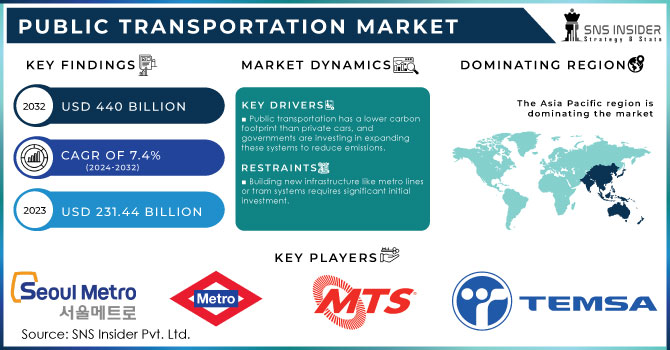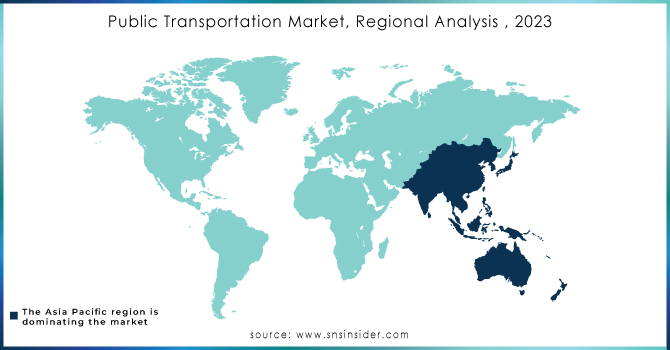Public Transportation Market Size & Overview

Get More Information on Public Transportation Market - Request Sample Report
The Public Transportation Market size was valued at USD 231.44 billion in 2023 and is expected to reach USD 440 billion by 2032 and grow at a CAGR of 7.4% over the forecast period 2024-2032. As cities expand and populations rise, efficient and affordable transportation becomes a necessity. Public transportation systems provide a cost-effective way for people to commute to work, access education, and participate in social activities, reducing traffic congestion and reliance on personal vehicles. The growing environmental concerns are pushing a shift towards sustainable transportation options. Public transportation has a lower carbon footprint compared to private cars, contributing to cleaner air and reduced greenhouse gas emissions. Governments around the world are actively investing in expanding public transport infrastructure and promoting its use through subsidies and incentives.
Integration of intelligent transportation systems (ITS) is optimizing routes, improving passenger information, and streamlining fare collection. For example, real-time arrival and departure information displayed at bus stops and train stations allows passengers to plan their journeys more efficiently. The cashless fare payment systems using mobile apps or contactless cards offer convenience and faster boarding times. High upfront costs for infrastructure development, particularly for new metro lines or tram systems, can be a hurdle. Ensuring efficient and well-maintained public transport networks requires ongoing investment, which can be a challenge for some municipalities.
Public Transportation Market Dynamics:
Key Drivers:
- Public transportation has a lower carbon footprint than private cars, and governments are investing in expanding these systems to reduce emissions.
- As the cost of gasoline and diesel continues to rise, public transportation becomes a more affordable option for many people.
As the price at the pump goes up, individual car ownership and operation become a more significant financial burden for many people. This economic pressure creates a natural shift towards public transportation, which offers a more cost-effective way to travel. Rising fuel costs translate to a higher monthly budget dedicated solely to transportation. Public transportation, on the other hand, provides a fixed-rate option, regardless of fluctuating fuel prices. This predictability and affordability make it a more attractive choice, especially for budget-conscious individuals and families. The public transportation eliminates the need for car maintenance, further reducing transportation-related expenses. The increasing cost of gasoline and diesel acts as a powerful incentive for people to explore and adopt public transportation, ultimately contributing to a more sustainable and economically viable transportation landscape.
Restraints:
- Building new infrastructure like metro lines or tram systems requires significant initial investment.
- The rise of ride-hailing apps like Uber and Lyft provides an alternative for some commuters, potentially impacting ridership on public transport.
The emergence of ride-hailing apps like Uber and Lyft has introduced a new competitor to public transportation, potentially impacting ridership. These app-based services offer on-demand car rides with features like convenient pick-up and drop-off locations, often perceived as more convenient than fixed public transport routes and schedules. This convenience factor, coupled with sometimes competitive pricing, can entice some commuters, particularly those who might have previously relied on buses or trains, to switch to ride-hailing services. This shift could lead to a decrease in public transport ridership, impacting revenue generation for public transport authorities.
Opportunities:
- Collaboration between public authorities and private companies can accelerate infrastructure development and service innovation.
- Prioritizing comfort, safety, and real-time information through upgrades and mobile apps can attract new riders.
Challenges:
- Overcoming negative stereotypes about safety, cleanliness, or reliability is crucial to attracting new riders.
Public Transportation Market Segmentation:
by Distribution Channel
- Online
- Offline
Offline is the dominating sub-segment in the Public Transportation Market by distribution channel holding around 70-80% of market share. Public transportation ticketing is primarily dominated by offline channels. This dominance can be attributed to several factors. The significant portion of the public transportation user base, particularly in developing economies, might lack access to smartphones or internet connectivity, making online ticketing impractical. The fare collection systems at stations and onboard vehicles are often not yet fully integrated with online payment options. Some users prefer the familiarity and convenience of purchasing tickets in person at kiosks or booths, especially for occasional travellers or those buying multi-day passes.
by Mode Type
- Road
- Rail
- Others
Road is the dominating sub-segment in the Public Transportation Market by mode type. Road-based public transportation, encompassing buses, trams, and trolleybuses, remains the dominant mode type in the Public Transportation Market. Road-based systems offer greater flexibility in terms of route planning, allowing them to reach more neighbourhoods and cater to diverse travel needs within a city. The upfront cost of establishing and maintaining road infrastructure is generally lower compared to rail systems. The buses can be easily rerouted to navigate traffic congestion or accommodate special events, offering adaptability that fixed rail lines might lack.
by End Use
- Intracity
- Intercity
- Others
Intracity is the dominating sub-segment in the Public Transportation Market by end use. Intracity travel, encompassing daily commutes within a city or urban area, represents the dominant segment in the Public Transportation Market. This dominance is primarily driven by the high concentration of population and workplaces within cities. Public transportation systems provide a cost-effective and efficient way for residents to navigate urban centres, reducing traffic congestion and reliance on personal vehicles. Intracity routes typically experience high passenger volumes throughout the day, making them a significant revenue generator for public transport authorities.
by Application
- Rural
- Urban
by Mobility
- Bus
- Tram
- Train
- Car Sharing
- Others
by Propulsion
- Diesel
- Gasoline
- Electric
- Others
Public Transportation Market Regional Analyses
The Asia Pacific is the dominating region in the Public Transportation Market holding around 45-50% of market share. The rapid urbanization across Asian countries is driving the demand for efficient and affordable transportation solutions. The stringent emission regulations and growing environmental awareness are propelling a shift towards public transportation as a more sustainable alternative to private vehicles.
Europe holds the second-highest position in the Public Transportation Market. This strong presence is driven by a well-established and well-integrated public transport network across many European countries. The high population density in urban areas creates a demand for efficient public transportation systems to manage traffic congestion.
The Middle East and Africa region is experiencing the fastest growth trajectory in the Public Transportation Market, with the Compound Annual Growth Rate (CAGR) exceeding 6%. The increasing government investments in infrastructure development, including metro lines and bus rapid transit systems, are expanding public transportation options in many countries.

Get Customized Report as per your Business Requirement - Request For Customized Report
Regional Coverage:
North America
-
US
-
Canada
-
Mexico
Europe
-
Eastern Europe
-
Poland
-
Romania
-
Hungary
-
Turkey
-
Rest of Eastern Europe
-
-
Western Europe
-
Germany
-
France
-
UK
-
Italy
-
Spain
-
Netherlands
-
Switzerland
-
Austria
-
Rest of Western Europe
-
Asia Pacific
-
China
-
India
-
Japan
-
South Korea
-
Vietnam
-
Singapore
-
Australia
-
Rest of Asia Pacific
Middle East & Africa
-
Middle East
-
UAE
-
Egypt
-
Saudi Arabia
-
Qatar
-
Rest of the Middle East
-
-
Africa
-
Nigeria
-
South Africa
-
Rest of Africa
-
Latin America
-
Brazil
-
Argentina
-
Colombia
-
Rest of Latin America
Key Players in Public Transportation Market
The major key players are Seoul Metro (South Korea), Madrid Metro, Transport For London (UK), The San Diego Metropolitan Transit System (US), TEMSA Global, MTR Corporation (Hong Kong), Metropolitan Transportation Authority (US), Gillig Corporation, Chicago Transit Authority (US), Bay Area Rapid Transit (BART) (US), and Massachusetts Bay Transportation Authority (US) and other key players.
Public Transportation Market Recent Development
-
In Jan. 2024: Senegal's President Macky Sall has launched a new fleet of e-buses in Dakar's public transport network. This initiative aims to enhance transportation sustainability and curb carbon emissions, marking a pivotal move towards greener mobility and combatting urban pollution. The e-buses offer a cleaner commuting option, promoting a sustainable transportation system for Dakar's residents.
-
In Dec. 2023: China prioritizes safety for self-driving public transport with new rules. These cover passenger well-being, secure operations, and emergency plans. They require passenger monitoring, speed limits, and malfunction shutdowns, while mandating software updates, network protection, and unforeseen scenario handling.
| Report Attributes | Details |
|---|---|
| Market Size in 2023 | US$ 231.44 Billion |
| Market Size by 2032 | US$ 440 Billion |
| CAGR | CAGR of 7.4% From 2024 to 2032 |
| Base Year | 2023 |
| Forecast Period | 2024-2032 |
| Historical Data | 2020-2022 |
| Report Scope & Coverage | Market Size, Segments Analysis, Competitive Landscape, Regional Analysis, DROC & SWOT Analysis, Forecast Outlook |
| Key Segments | • by Type (Bus, Light rail, Metro, Regional taxi, Tram) • by Application (Rural, City), |
| Regional Analysis/Coverage | North America (USA, Canada, Mexico), Europe (Germany, UK, France, Italy, Spain, Netherlands, Rest of Europe), Asia-Pacific (Japan, South Korea, China, India, Australia, Rest of Asia-Pacific), The Middle East & Africa (Israel, UAE, South Africa, Rest of Middle East & Africa), Latin America (Brazil, Argentina, Rest of Latin America) |
| Company Profiles | Seoul Metro (South Korea), Madrid Metro, Transport For London (UK), The San Diego Metropolitan Transit System (US), TEMSA Global, MTR Corporation (Hong Kong), Metropolitan Transportation Authority (US), Gillig Corporation, Chicago Transit Authority (US), Bay Area Rapid Transit (BART) (US), and Massachusetts Bay Transportation Authority (US) |
| Key Drivers | •Consumer preferences are shifting toward carpooling, train travel, ride-sharing, air travel, and bus travel. •Increase in urban population and easier and more convenient transportation for these people. •Many raw material supplying industries are shifting their focus to distributing their goods via public transportation. |
| RESTRAINTS | •Commute preference for passenger automobiles and two-wheelers is growing. •Political systems that favor public transportation investments stifle global market expansion. |

